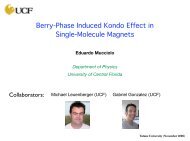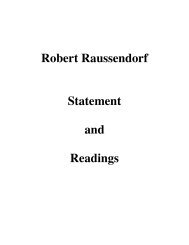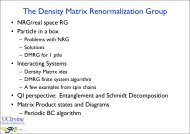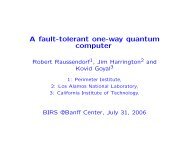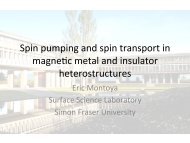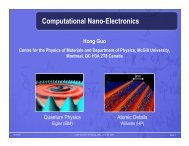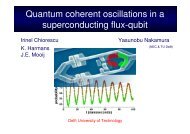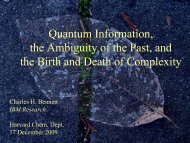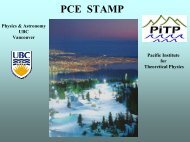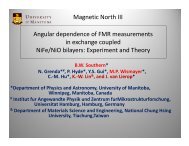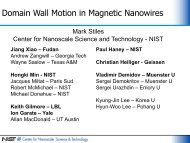LARGE-SCALE COHERENCE & DECOHERENCE - PiTP
LARGE-SCALE COHERENCE & DECOHERENCE - PiTP
LARGE-SCALE COHERENCE & DECOHERENCE - PiTP
Create successful ePaper yourself
Turn your PDF publications into a flip-book with our unique Google optimized e-Paper software.
PCE STAMP<br />
<strong>LARGE</strong>-<strong>SCALE</strong> <strong>COHERENCE</strong> & DE<strong>COHERENCE</strong><br />
Magnetic North, Banff, June 8th, 2012<br />
Physics & Astronomy<br />
UBC<br />
Vancouver<br />
Pacific Institute<br />
for<br />
Theoretical Physics
Web: http://www.physics.ubc.ca/~berciu/PHILIP/index.html<br />
Email: stamp@physics.ubc.ca
PART 1:<br />
MECHANISMS<br />
of<br />
ENVIRONMENTAL DE<strong>COHERENCE</strong>
ENVIRONMENTAL DE<strong>COHERENCE</strong> 100<br />
Ψ 1<br />
(Q)<br />
E<br />
Some quantum system with coordinate Q interacts<br />
with any other system (with coordinate x) ; typically<br />
they then form an entangled state<br />
Ψ 2<br />
(Q)<br />
Example: In a 2-slit expt., the particle coordinate Q couples to<br />
photon coordinates, so that:<br />
Ψ o<br />
(Q) Π q φ q<br />
in<br />
[a 1 Ψ 1 (Q) Π q φ q<br />
(1)<br />
+ a 2<br />
Ψ 2<br />
(Q) Π q<br />
φ q<br />
(2)<br />
]<br />
Now suppose we have no knowledge of / control over, the photon states – we then<br />
average over these states, consistent with the experimental constraints. In the extreme<br />
case this means we lose all information about the PHASES of the coefficients a 1<br />
& a 2<br />
(and in particular the relative phase between them).<br />
This process is called DE<strong>COHERENCE</strong><br />
NB 1: No requirement for energy to be exchanged between the system and the environment –<br />
only a communication of phase information.<br />
NB 2: Nor does phase interference between the 2 paths have to be associated with a noise<br />
coming from the environment- what matters is entanglement - that the state of the<br />
environment be CHANGED according to the what is the state of the system.
‘Oscillators’<br />
CURRENT MODELS of ENVIRONMENTAL DE<strong>COHERENCE</strong><br />
Bath:<br />
Bath:<br />
Int:<br />
Interaction:<br />
Very SMALL ( ~ O(1/N 1/2 )<br />
Phonons, photons, magnons, spinons,<br />
Holons, Electron-hole pairs, gravitons,..<br />
DELOCALIZED<br />
BATH MODES<br />
OSCILLATOR<br />
BATH<br />
Defects, dislocation modes, vibrons,<br />
Localized electrons, spin impurities,<br />
nuclear spins, …<br />
LOCALIZED<br />
BATH MODES<br />
SPIN BATH<br />
NOT SMALL !
MECHANISMS of ENVIRONMENTAL DE<strong>COHERENCE</strong>: a SIMPLE PICTURE<br />
Easiest to visualize this in path integral theory:<br />
(1) OSCILLATOR BATH<br />
Oscillator Lagrangian:<br />
Each oscillator is subject to a force<br />
Problem is exactly solvable (Feynman). Each oscillator very weakly coupled<br />
to system, and slowly entangles with it…weak excitation of oscillator<br />
(2) SPIN BATH Each bath spin has the Lagrangian<br />
The ‘topological term’<br />
with the force:<br />
gives an added phase<br />
Entanglement with system via<br />
This problem is highly non-trivial (in general<br />
UNSOLVABLE even for spin-1/2 !).<br />
(not weak)<br />
We also have a small ‘internal noise’ term, of form
EXAMPLE: CENTRAL SPIN DYNAMICS<br />
A beautiful test case for<br />
decoherence theory –<br />
which predicts Qubit dynamics is dominated by ‘precessional<br />
decoherence’ from the spin bath. This precessional<br />
decoherence has NO DISSIPATION – it is invisible in<br />
energy relaxation, but causes very strong decoherence.<br />
For a qubit write:<br />
Precessional<br />
path for bath spin<br />
where<br />
Path of field on<br />
bath spin from<br />
Qubit – it jumps<br />
quickly between 2<br />
orientations<br />
Precessional decoherence rates are<br />
High field<br />
Low field<br />
The only dissipation in the problem comes from the<br />
departures from the sudden approximation, & from the<br />
weak bath noise term – both very small.<br />
The lineshape is not conventional at all; see RIGHT:<br />
For Central Spin model, see:<br />
NV Prokof’ev, PCE Stamp, Rep Prog Phys 63, 669 (2000)<br />
LONG-TIME TAILS<br />
(Non-monotonic<br />
in time)
PART 2:<br />
So much for the Theory..<br />
Now let’s go back to the<br />
REAL WORLD<br />
APPLICATION<br />
to<br />
EXPERIMENT<br />
MV Berry: Ann NY Acad Sci 755, 303 (1995)
EXAMPLE 1: The Fe-8 MOLECULE – A SPIN QUBIT<br />
Low-T Quantum regime- effective Hamiltonian<br />
(T < 0.36 K):<br />
Longitudinal bias:<br />
Eigenstates:<br />
Fe 8 S = 10<br />
defines orthonormal states:<br />
Feynman Paths on the spin sphere for<br />
a biaxial potential. Application of a<br />
field pulls the paths towards the field
GEOMETRICAL ARRANGEMENT<br />
We have:<br />
(i) Intermolecular dipolar coupling<br />
(ii) Hyperfine coupling<br />
(iii)Spin-phonon coupling<br />
Each causes decoherence<br />
NB: this is not the only kind of process<br />
that can occur in a qubit network. In,<br />
eg., a ‘topological quantum computer’,<br />
One has non-local decoherence<br />
processes<br />
IS Tupitsyn, A Kitaev, NV Prokof’ev, PCE Stamp<br />
Phys Rev B82, 085114 (2010)
QUANTUM <strong>COHERENCE</strong> REGIME: quantitative predictions made<br />
long before experiments: A Morello et al., PRL 97, 207206 (2006)<br />
DE<strong>COHERENCE</strong> IN Fe-8 SYSTEM<br />
(A) Nuclear Spin Bath<br />
Hyperfine couplings of<br />
all 213 nuclear spins are<br />
well known<br />
Nuclear spin decoherence rate<br />
where<br />
(b) Phonon Bath<br />
Phonon spectrum and spin-phonon couplings<br />
are known. Phonon decoherence rate is:<br />
Total SINGLE QUBIT decoherence rate<br />
shown in Figure at right:
(c) Dipolar Decoherence<br />
This is an example of “correlated errors” caused by inter-qubit interactions.<br />
It turns out to be very serious.<br />
The high-T (van Vleck) limiting form is<br />
At low T one gets a quite different form<br />
RESONANT SURFACES
THEORY vs. EXPERIMENT<br />
Let’s summarize the theoretical predictions,<br />
for an experiment finally performed in 2011:<br />
(dipolar)<br />
nuclear rate<br />
(isotopically purified)<br />
1. First detection of macroscopic spin<br />
precession of qubits<br />
2. Lowest decoherence rate ever seen<br />
in molecular spins.<br />
EXPERIMENT<br />
Used high-field<br />
Hahn echo ESR<br />
at 240 GHz, on 2<br />
different samples<br />
in various field<br />
orientations.<br />
3. First measurement of dipole<br />
decoherence in qubit array<br />
4. First controlled mmt of decoherence<br />
rates from spin bath, oscillator bath, &<br />
dipolar interactions (agreed with theory)<br />
S Takahashi et al., Nature 476, 76 (2011)
EXAMPLE 2: DYNAMICS of a QUANTUM VORTEX<br />
STANDARD “HVI” PHENOMENOLOGY:<br />
with the Magnus force:<br />
+ quasiparticle force:<br />
(Iordanskii)<br />
This gives MUTUAL FRICTION:<br />
where<br />
These phenomenological eqtns have been very controversial. They are applied to both<br />
superfluids and superconductors (one simply has to find the coefficients in each case).<br />
SPIN VORTEX DYNAMICS<br />
One arrives at a similar classical equation of motion:<br />
The gyrotropic (Magnus) force is<br />
and p, q, are the core polarization and winding number.<br />
THESE EQUATIONS CANNOT BE RIGHT FOR A QUANTUM VORTEX !
VORTEX DYNAMICS: the PROBLEM<br />
1) FULLY QUANTUM TREATMENT Given an N-particle wave-fn<br />
(with )<br />
and density operator:<br />
Define the reduced density matrix<br />
: the N-1 collective coordinates<br />
adapted to the position R of the vortex node<br />
Propagator of<br />
density matrix:<br />
(Non-<br />
Perturbative)<br />
where<br />
0<br />
is a bare vortex action<br />
2) SOLITONIC FIELD THEORY The 2 nd subtlety – the vortex soliton interacts not<br />
with bare quasiparticles, but with ‘renormalized’ modes orthogonal to the soliton.<br />
These modes are quite different from the original quasiparticles.<br />
The scattering matrix element is IR divergent:<br />
This is a very peculiar field theory, which has<br />
to be solved non-perturbatively<br />
Renormalized quasiparticles
SOLUTION TO THE PROBLEM<br />
Let’s first Fourier transform:<br />
HVI eqtns become:<br />
driving force:<br />
L Thompson, PCE Stamp, PRL 108, 184501 (2012)<br />
where<br />
“admittance” matrix:<br />
CORRECT FULL EQUATION of MOTION<br />
Quantum<br />
Regime:<br />
new driving force:<br />
Longitudinal Drag (non-local in time)<br />
Noise correlator (very non-Markovian)
Quantum Vortex in 2D Easy-plane Ferromagnet<br />
Hamiltonia<br />
Continuum<br />
The action is:<br />
+<br />
where<br />
(Berry<br />
The vortex is a ‘skyrmion’, with profile:<br />
Vortex<br />
core radius<br />
VORTEX-MAGNON INTERACTION<br />
Basic arguments go through as before.<br />
BARE MAGNON SPECTRUM<br />
with Spin Wave velocity:<br />
with<br />
Interaction action:<br />
Magnon eqtns of motion:
MAGNETIC VORTICES<br />
INTERACTION WITH MAGNONS<br />
The results can be physically interpreted<br />
in terms of interaction between travelling<br />
spinning gyroscope (the magnon) and a<br />
massive spinning string (the vortex).<br />
Mz (moving Vortex)<br />
Metric Curvature (moving vortex)<br />
The deSitter (geodesic) and Lense-<br />
Thirring effects cancel – there is no<br />
Iordanski force!<br />
Metric curvature (static vortex)<br />
EXAMPLE: PERMALLOY<br />
We have<br />
RIGHT: high-T<br />
experiments.<br />
Low-T regime<br />
is below 8K<br />
Key parameters:<br />
get<br />
get
VORTEX DYNAMICS: RESULTS<br />
simulated vortex motion<br />
motion with Ohmic damping<br />
If we set the vortex into motion with a δ-kick, we<br />
find decaying spiral motion dependent on the<br />
initial vortex speed (shown in fractions of v 0<br />
= c/r v<br />
)<br />
The top inset shows the<br />
necessary γ of Ohmic<br />
damping to fit full simulated<br />
motion. Note the strong<br />
upturn at low speeds!
EXAMPLE 2: <strong>COHERENCE</strong>/DE<strong>COHERENCE</strong> in BIOMOLECULES<br />
LIGHT-HARVESTING MOLECULES<br />
CHEMICAL COMPASSES<br />
Energy is transported around RINGS by<br />
excitons, created by low-intensity (but high<br />
energy) sunlight. Quantum yield is ~ 98%.<br />
Old model of incoherent dynamics is wrong.<br />
Need new models & results.<br />
Light absorption creates spin pair of<br />
entangled radicals – one or both move<br />
around rings. Their recombination controls<br />
chemical reaction in eye navigation.<br />
(Spin dynamics controlled by nuclear<br />
spins + Earth’s field).<br />
Need proper understanding of dynamics –<br />
which is controlled by nuclear spin bath<br />
E Collini et al, Nature 463, 644 (2010)<br />
GS Engel et al, Nature 446, 782 (2007)<br />
H Lee et al, Science 316, 1462 (2007)<br />
K Maeda et al, Nature 453, 387 (2008)<br />
CT Rodgers, PJ Hore, PNAS 106, 353 (2009)
DE<strong>COHERENCE</strong> of CHARGE CARRIERS in BIOMOLECULES<br />
Charge carriers in biomolecules: Polarons & Excitons. Dynamics is poorly understood.<br />
Even simple polaron has surprises. Consider non-diagonal coupling to phonons:<br />
The effect of this is dramatic – led to<br />
our discovery of sharp ‘critical<br />
transition’ in dynamics (no analogue for<br />
diagonal couplings).<br />
- Important for biomolecules<br />
DJ Marchand et al., PRL 105, 266605 (2010)<br />
}Dimensionless coupling<br />
MODEL of CHARGE DYNAMICS<br />
Polarons/excitons interact with delocalized<br />
& localized phonons. Key model:<br />
Band<br />
Bath<br />
+<br />
Very interesting<br />
dynamics!<br />
Z Zhu, A Aharony, O Entin, PCE Stamp,<br />
PR A81, 062127 (2010)
3 rd PARTY DE<strong>COHERENCE</strong>:<br />
This is decoherence in the dynamics of a system A<br />
(with coordinate Q) caused by indirect entanglement with<br />
an environment E- the entanglement is achieved via a 3 rd<br />
party B (coordinate X).<br />
Ex: Buckyball decoherence<br />
Consider the 2-slit expt with buckyballs. The COM<br />
coordinate Q of the buckyball does not couple directly to<br />
the vibrational modes {qk } of the buckyball - by definition.<br />
However BOTH couple to the slits in the system, in a<br />
distinguishable way.<br />
Note: the state of the 2 slits, described by a coordinate<br />
X, is irrelevant- it does not need to change at all. We can<br />
think of it as a scattering potential, caused by a system with<br />
infinite mass. It is a PASSIVE 3 rd party. We can also have ACTIVE<br />
3 rd parties<br />
PCE Stamp, Stud. Hist Phil Mod Phys 37, 467 (2006)<br />
See also PCE Stamp, WG Unruh, in preparation
PART 3:<br />
INTRINSIC<br />
DE<strong>COHERENCE</strong>
INTRINSIC DE<strong>COHERENCE</strong><br />
This has nothing to do with environments at all – IT AMOUNTS TO A<br />
BREAKDOWN OF QUANTUM MECHANICS.<br />
Such possibilities have been advocated for reasons, notably because they<br />
purport to<br />
(i) Solve the Quantum Mmt problem<br />
(ii) Reconcile Quantum Mechanics and Gravity<br />
NON-LINEAR SCHRODINGER EQTN<br />
Lots of different suggestions here (Pearle, Ghirardi et al, Milburn, Diosi, etc..<br />
One of the more precise suggestions results in<br />
So far only definitive tests of Weinberg’s 1989 suggestion – QM won out<br />
GRAVITATIONAL DE<strong>COHERENCE</strong><br />
(i) Decoherence from quantum fluctuations in Spacetime (Hawking, Ellis, ..)<br />
(ii) Decoherence from implementation of the ‘Holographic principle (‘t Hooft)<br />
(iii) Decoherence from uncertainty in quantum time (Diosi, Penrose,…)<br />
We will look at option (iii).
SOME TESTS of Gen Relativity<br />
BINARY PULSAR<br />
GRAVITATIONAL<br />
LENSING<br />
MASSIVE<br />
BLACK HOLES<br />
Now in excess<br />
of 10 7 solar<br />
masses<br />
Once a curiousity,<br />
these lenses have<br />
become an<br />
essential tool in<br />
observational<br />
cosmology
GRAVITATIONAL DE<strong>COHERENCE</strong><br />
There are v good arguments to show<br />
we need to quantize gravity. Consider<br />
superposition at left<br />
Initial state:<br />
Time evolution:<br />
Suppose now we perform a<br />
measurement – does the<br />
energy-momentum tensor ‘collapse’?<br />
No: causes discontinuity, violating<br />
So – we cannot write<br />
Rough argument for the existence of an ‘intrinsic gravitational decoherence’:<br />
Gravitational interaction energy:<br />
Energy Uncertainty<br />
L Diosi, Phys Rev A40, 1165 (1989)<br />
R Penrose, “Shadows of the Mind” (OUP, 1994)<br />
W. Marshall, C. Simon, R. Penrose,<br />
D. Bouwmeester: PRL 91, 130401 (2003).<br />
Then there will be a timescale of<br />
loss of phase coherence, given by<br />
Time-energy uncertainty relation.
INTRINSIC DE<strong>COHERENCE</strong>: a THEORETICAL FORMULATION<br />
PCE Stamp, Phil Trans Roy Soc A (in press); arXiv 1205.5307<br />
“A theory is not a theory until it produces a number”<br />
R.P. Feynman (Lectures on Physics, 1965)<br />
Path integral QM:<br />
Let’s now introduce a modification of QM, as follows:<br />
Let:<br />
where<br />
For gravitational decoherence, we introduce<br />
The picture is then:<br />
Standard QM<br />
Modification to QM
The effect of this term on the propagator is just a renormalization; eg.,<br />
for a free particle we have:<br />
containing a ‘Coulomb’ renormalization.<br />
However the effect on the density matrix evolution is more profound.<br />
Writing<br />
for the density matrix propagation, we now have<br />
with(in the case of gravitational decoherence) a correction:<br />
and this causes intrinsic decoherence<br />
All of this is for a single particle. We also, if we want to compare with<br />
experiments, do this for a larger body. How do we do this?
SLOW & FAST VARIABLES in this THEORY<br />
The easiest way to treat real experiments in this formalism is to make a<br />
Born-Oppenheimer separation between slow and fast variables. Recall<br />
that in ordinary QM we have<br />
where the fast propagator is<br />
If we now integrate out the fast variables, we get an effective<br />
propagator for the slow variables which contains extra terms. Instead of<br />
just the slow Lagrangian, conventional QM gives<br />
and then the extra gravitational term gives a contribution:<br />
where<br />
So – now we need an experiment to look at!
BOUWMEESTER EXPERIMENT: DETAILS<br />
If we ignore environmental decoherence<br />
in this experiment, we have a system in<br />
which we have a photon in a<br />
superposition of cavity A and cavity B<br />
states, with an entanglement to a<br />
cantilever vibrational mode C, via the<br />
small mirror M on C. The Hamiltonian is<br />
taken to be<br />
where<br />
The if at t = 0 we are in the state<br />
the system evolves to time t to the state:<br />
C<br />
with off-diagonal matrix element<br />
Environmental decoherence...almost solved<br />
D Kleckner et al., N J Phys 10, 095020 (2008)<br />
C<br />
Intrinsic Decoherence … stay tuned…..
THANK THANK YOU YOU TO: TO:<br />
IS IS Tupitsyn<br />
(PITP, UBC)<br />
L Thompson (MIT)<br />
WG Unruh (UBC)<br />
A A Morello<br />
(UNSW)<br />
S S Takahashi (UCSB/USC)



